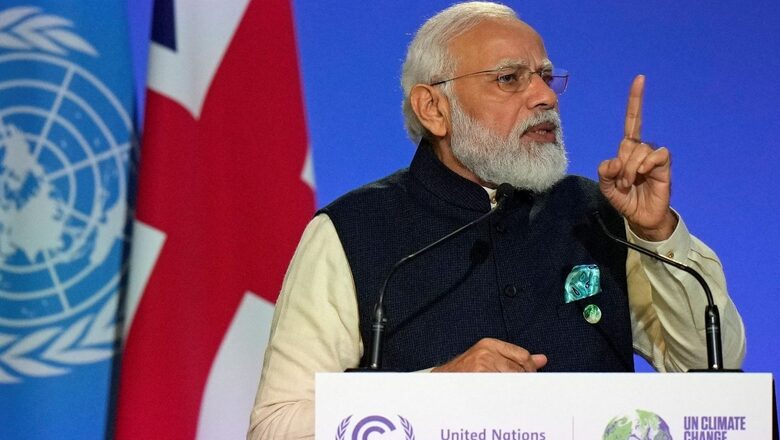
views
Prime Minister Narendra Modi stood tall at the COP26 Summit in Glasgow as he showcased how India is the only country that is delivering in “letter and spirit” the commitments on tackling climate change under the Paris Agreement. While emphasising that India would achieve net-zero carbon emissions by 2070, reach its non-fossil energy capacity to 500 GW and also meet 50 per cent of its energy requirements from renewable energy by 2030, Prime Minister Modi made a big impression on the world stage. He, in that way, showed the way to lead the world in dealing with issues of such global concerns.
India’s leadership in dealing with climate change will spur other countries to raise their own contributions in meeting this global challenge. The crux is to find the right balance between national interest and international responsibility. India, under Prime Minister Modi, has proved that it is possible to have growth and development while preserving the ecology.
Prime Minister Modi has taken the lead in defending the climate. His personal intervention in the adoption of the landmark 2015 Paris Agreement was acknowledged by several world leaders. His initiative on setting up an International Solar Alliance for promoting solar power worldwide was widely welcomed.
Addressing COP26 two days ago, the biggest climate conference on earth, Prime Minister Modi quoted an ancient Indian green blessing: “Sarve bhavantu sukhinah (may all be happy).”
ALSO READ | COP26: With Developed World Not Doing Its Bit, India’s Case for Climate Justice is Strong
In July 2021, 15,000 of the world’s leading scientists declared a climate emergency warning that we have 12 years to limit global warming to a maximum of 1.5C and avoid climate breakdown. The window to save our world from the shameless overexploitation of its resources is closing.
Climate impacts are evident fast and furious. Almost 200 countries signed the UN Framework Convention on Climate Change in Paris in 2015. They agreed to limit global warming to below 2 degrees Celsius of pre-industrial levels, possibly at 1.5 degrees Celsius. Many agreed on zero net emissions within a few decades, meaning that the same amount of greenhouse gases would be removed as emitted.
Each country was to produce a nationally-determined contribution (NDC) to the global effort including electric vehicles, renewable energy and forest protection. Unfortunately, when combined, all the NDCs are far short of the goals.
In 2009, rich countries promised $100 billion a year by 2020 to help developing countries fight climate change. It still remains a promise.
We need to cut emissions annually by 7 per cent between now and 2030, but last year, even amid COVID-induced global lockdown, emissions could fall by 6 per cent. The US has promised to cut emissions by half by 2030 and reach net zero emissions by 2050.
In Glasgow, India launched a drive to safeguard infrastructure in small island states. Rising sea levels is an existential threat for them. The new programme for the small island states is part of the Coalition for Disaster Resilient Infrastructure (CDRI), an Indian initiative announced by Prime Minister Modi at the UN General Assembly in 2019.
Climate change is a “crisis multiplier” that has profound implications for international peace and stability with its acute effects on food security, natural resources and migration patterns, Secretary-General António Guterres told the Security Council in February 2021.
Over the course of the Earth’s 4.5-billion-year history, the climate has changed a lot. But the rapid warming we’re seeing now can’t be explained by natural cycles of warming and cooling. The changes that would normally happen over hundreds of thousands of years are happening in decades.
Global temperatures are now at their highest in recorded history. Seventeen of the 18 warmest years on record have all taken place since 2001.
Climate emergency is the defining issue of our time. The last decade was the hottest in human history. Wildfires, cyclones, floods and droughts are now the new normal, damaging not only the environment but also weakening our political, economic and social systems.
ALSO READ | How Indian Policymakers and Citizens Should Read IPCC Report’s Code Red for Humanity
The Germanwatch Institute’s Global Climate Risk Index 2020 identifies Japan, the Philippines, Germany, Madagascar, India, Sri Lanka, Kenya, Rwanda, Canada, Fiji, as the most affected by climate change. India is a major victim of extreme heat, floods, and sandstorms, among other devastating natural events. A government study suggests that Canada is warming twice as fast as the rest of the planet. We have seen Australia burning and losing 8.4 million hectares.
The most visible effect of climate change is the melting of polar ice and glaciers, causing sea levels to rise. In one month alone, Greenland lost over 197 billion tonnes of water due to an ice sheet melting, according to researchers at the Danish Meteorological Institute.
So far in 2021, about 50,000 reported wildfires in the US have caused moderate to severe drought in about 90 per cent of land in the western states and degraded over 10 million acres.
Climate change is a global phenomenon but with local consequences. We have seen devastating floods in China and Germany, a heatwave in Siberia. On June 23, 2021, ground stations in Moscow measured an air temperature of 34.8°C (94.6°F) — the city’s hottest June temperature on record.
The climate of Latin America is getting hotter and drier. The greenhouse effect of excess carbon dioxide and methane emissions makes the Amazon rainforest hotter and drier, resulting in more wildfires in Brazil. Climate change in Africa is leading to increased temperatures and rainfall variability.
Madagascar, which was self-sufficient in agriculture, now faces famine owing to climate change. Its southern part has had no rain for five years; people are eating locusts, shoe leather, leaves.
Climate change also causes conflict. In Sudan, where I served as Ambassador for many years, desertification drives hundreds of thousands to seek pasture in greener areas, sparking conflict with locals.
And climate change causes natural disasters. Climate-related disasters have tripled in the last 30 years. The main causes of climate change are:
1) Increased use of fossil fuels such as coal, oil, and gas to generate electricity, run cars and other forms of transport, manufacturing and industry.
2) Deforestation, because living trees absorb and store carbon dioxide.
3) Increasingly intensive agriculture, which emits greenhouse gases like methane and nitrous oxide.
Anyone who doesn’t believe that climate change is happening doesn’t believe in science. In September 2021 US Climate Change representative John Kerry told the Chinese leadership that climate change was more important than politics. However, China’s Foreign Minister Wang Yi claimed that the worsening bilateral relationship could hamper future cooperation on climate issues, forgetting that climate is not ideological, not partisan, and definitely not a geostrategic weapon.
While India has been the most active in fighting climate change, according to Bloomberg’s Climate Policy Factbook, eight G-20 countries, including the US, Canada and Australia, increased their financial support for oil, coal and gas from 2015-20.
Climate change must be fought not in silos but in an integrated, comprehensive, and holistic way, as Prime Minister Modi had said at a G20 event last year. The world can progress faster if there is greater support in technology and finance for developing nations. The targets India has voluntarily committed itself to are unprecedented for a developing country.
India’s commitment to ecologically sustainable economic development is linked with its age-old civilisational values of respecting nature, incorporating a sense of inter-generational equity, and common humanity. Remember the Chipko forest conservation movement in India around 1973 in the Himalayan region of Uttarakhand that went on to become a rallying point for many future environmental movements all over the world?
The Modi government, in particular, has taken several momentous decisions in its fight against climate change and global warming. The Swachh Bharat Abhiyan has eliminated open defecation through 110 million new toilets and a superb awareness campaign, protecting our water bodies from human pollution.
Free or subsidised distribution of 350 million LED bulbs has dramatically reduced electricity consumption. Single-use plastic will be banned from August 2022. Forest cover is increasing exponentially. A world record of planting 50 million trees in one day was set in 2016.
For every additional dollar of GDP, India will be using progressively lesser amounts of energy. India’s latest target of achieving 50 per cent (500 GW) of its energy requirement from renewable sources by 2030 is likely to be achieved in advance (we are at 40 per cent already).
India is among the top three renewable energy producers in the world, building massive solar farms. Degraded land is being recovered faster than any other country. We have recovered well over 10 million hectares of degraded land in the past decade, the target being 26 million by 2030.
Solar tariffs in India are now below even the fuel costs of running most existing coal-fired power plants. In the last 12 months, no new coal-fired power plants have been announced.
The National Thermal Power Corporation has begun a pivot towards renewables, saying no more greenfield development of coal-fired power projects and announcing a target to install 32GW of renewable energy capacity by 2032.
The good news is that we have the solutions—the technology for a low-carbon future already exists with real, technically feasible, affordable alternatives to fossil fuels. Green hydrogen is the most exciting. We will achieve net-zero emissions by 2070, possibly earlier.
While the world may never return to the stable climate that gave birth to civilisation, if COP26 recognises climate change as a global security threat, we may yet act in time. And in all this, Prime Minister Modi’s role would undoubtedly be a defining one.
Ambassador Deepak Vohra is Special Advisor to the Prime Minister, Lesotho, South Sudan, and Guinea-Bissau; and a Special Advisor to Ladakh Autonomous Hill Development Councils, Leh and Kargil. The views expressed in this article are those of the author and do not represent the stand of this publication.
Read all the Latest News , Breaking News and IPL 2022 Live Updates here.

















Comments
0 comment